Abstract
Tannic acid-doped polypyrrole (PPY/TA) films have been grown on gold electrodes for selective electrochemical detection of dopamine (DA). Electrochemical quartz crystal microbalance (EQCM) studies revealed that, in vivid contrast to perchlorate-doped polypyrrole films (PPY/ClO4-), the redox switching of PPY/TA films in aqueous solutions involved only cation transport if the solution pH was greater than 3∼4. The PPY/TA Au electrodes also exhibited attractive permselectivity for electroactive cations, namely, effectively blocking the electrochemical reactions of anionic ferricyanide and ascorbic acid (AA) while well retaining the electrochemical activities of hexaammineruthenium (III) and dopamine as cationic species. A 500 Hz PPY/TA film could effectively block the redox current of up to 5.0 mM AA. The coexistence of ascorbic acid in the measurement solution notably enhanced the current signal for dopamine oxidation, due probably to the chemical regeneration of dopamine through an ascorbic acid-catalyzed reduction of the electro-oxidation product of dopamine (EC’ mechanism), and the greatest amplification was found at an ascorbic acid concentration of 1.0 mM. The differential pulse voltammetry peak current for DA oxidation was linear with DA concentration in the range of 0 to 10 μM, with sensitivity of 0.125 and 0.268 μA/μM, as well as lower detection limit of 2.0 and 0.3 μM in a PBS solution without AA and with 1.0 mM coexisting AA, respectively.
1. Introduction
The area of electroactive polymers confined to different electrode surfaces has received great attention. Polymer-modified electrodes (PMEs), in contrast to metallic or carbon substrate electrodes, can be designed through polymer screening to provide tremendous improvements in sensitivity and selectivity to detect variety of analytes. These electrodes have been demonstrated to be useful for improving ionic permselectivity, the stability and reproducibility of the electrode response, and for favorably realizing electrocatalytic chemical analysis [1-8]. Also, the electroactive films have been used to entrap different biomolecules at the electrode surface, but without obvious loss of their bioactivity, for the development of biosensors [9-10].
Electroploymerization is well known as a very convenient way to immobilize polymers at the electrode surface, and the thickness, permeation and charge transport characteristics of the polymeric films can be easily and precisely controlled by modulating the electrochemical parameters for various electrochemical methods.
Dopamine (DA) is a ubiquitous neurotransmitter in mammalian brain tissues. It possesses a strong electrochemical activity and thus has been widely studied by electroanalytical chemists. However, a major obstacle in the electrochemical detection of DA directly at metallic or carbon electrodes is the interference of ascorbic acid (AA), which coexists with DA in central nervous systems and is oxidized in the almost same potential range as DA is done on bare gold electrodes [11]. For example, the AA concentration was up to 200 μM in rat brain tissue, while a corresponding figure for DA was 20 nM [12]. In order to overcome this problem, a variety of electrochemical techniques have been explored, and several strategies for modifying the electrode surfaces to enhance the selectivity of the analysis have been developed [3-8,11-19].
In biological environments (pH 7.4), DA exists as cation (pKa=8.87) while AA exists as anion (pKa=4.10) [3,4,14]. The negatively charged polymer film-modified electrodes have been used to suppress the interference of AA with the determination of DA [3,4,11,12,18]. Adams et al. utilized an anionic polymer, Nafion, which repels AA and other negatively charged interferences, while attracting positively charged DA [19]. Although Nafion coating introduced the desired specificity, it has some disadvantages, e.g., relatively thick film is required and thus delayed response time of the sensor [20].
Tannic acid (TA) is typical hydrolyzed tannin, a mixed gallotannin composed of gallic acid esters of glucose [21]. In tannic acid molecule, there is high electron density of phenyl, carbonyl and hydroxyl groups, and the sizes of these molecules are large. Since the anions having large molecule sizes are tightly entrapped in the polypyrrole backbone [22], polypyrrole films with TA as the dopant (PPY/TA) may thus selectively transport cations. In this paper, polypyrrole films doped with tannic acid have been grown on gold electrodes by electropolymerization of pyrrole and used for selective electrochemical detection of DA. Results show that the PPY/DA electrodes exhibit good ionic permselectivity and the electro-oxidation of AA at these electrodes can be efficiently suppressed.
2. Experimental
2.1. Reagents
Pyrrole was distilled to give a colorless liquid under nitrogen atmosphere prior to use. Hexamineruthenium(III) chloride (Ru(NH3)63+) was purchased from Aldrich, and dopamine was purchased from Sigma. Other reagents used in this work were of analytical grade or better quality.
The phosphate buffer solutions (PBS) were prepared by mixing 8.0 mM Na2HPO4, 1.5 mM KH2PO4 and 0.1 M Na2SO4, whose pH value was 7.4. Doubly distilled water was used throughout the experiments.
2.2. Apparatus
EQCM experiments were carried out with a CHI660A electrochemical workstation (CH Instruments Co., USA) and a research quartz crystal microbalance (Maxtek Inc., USA), for the combination of the instruments in this work. The research quartz crystal microbalance (RQCM) is able to accurately record the resonant frequency (f0) and the motional resistance (R1) of the crystal via its high performance phase lock oscillator (PLO) circuit, as given in the operation manual provided by the manufacturer. Also, the good coincidence of the f0 and R1 responses to the increase of sucrose concentration, between those obtained by using the RQCM and a HP4395A impedance analyzer [23], has been obtained after careful examinations in this laboratory. A magnetic stirrer and a stirring bar were used for the convective transport when necessary.
AT-cut 9-MHz gold-coated piezoelectric quartz crystals (12 mm in diameter) were used. The AT-cut crystals were cut at an angle of approximately 35o with respect to the optical axis, which exhibit high frequency stability and possess a very low frequency-temperature coefficient between 0 and 50 oC. The gold electrode of a ca. 6.5-mm diameter on one side of the piezoelectric quartz crystal (PQC) contacted the solution and served as the working electrode, while the other side of the PQC was located in air. The reference electrode was a saturated KCl calomel electrode (SCE), and all potentials are referred to the SCE in this article. A carbon rod served as the counter electrode. All the experiments were performed at room temperature.
2.3. Procedures
The PQC Au working electrode was cleaned by dropping 1∼2 drops of the mixture of hydrogen peroxide and concentrated sulfuric acid (v/v 3:1) on the surface for about 10 s, and then was rinsed by doubly distilled water. This treatment was repeated for three times. Then, the electrode was subject to potential cycling (between 0 to +1.5 V at 50 mV/s) in 0.2 M HClO4 aqueous solution for sufficient cycles till voltammograms and the frequency and resistance responses were reproducible [24]. A PPY film was then grown on the gold electrodes by pyrrole electropolymerization through cyclic potential sweeps (50 mV/s) in the 0∼0.7 V range. The solutions used were 20 mM pyrrole aqueous solution containing 5.0 mM tannic acid or 5.0 mM sodium perchlorate as the supporting electrolyte. For comparison, the pH of the perchlorate polymerization solution was adjusted by adding 0.1 M HClO4 to ca. 3.5, the pH of the tannic acid polymerization solution. Before electropolymerization, these solutions were deoxygenated by purging high-purity nitrogen for about 30 min. The amount of surface deposits was controlled by the PQC frequency response.
3. Results and discussion
3.1. Electrochemical growth of polymers
A PPY/TA film can be easily synthesized by electrochemical oxidation of pyrrole monomers using tannic acid as the supporting electrolyte. Figure 1 shows the in situ records of current, Δf0 and ΔR1 in the cyclic voltammetric polymerization process of 20 mM pyrrole aqueous solution containing 5.0 mM tannic acid (A-C) or 5.0 mM sodium perchlorate (D).
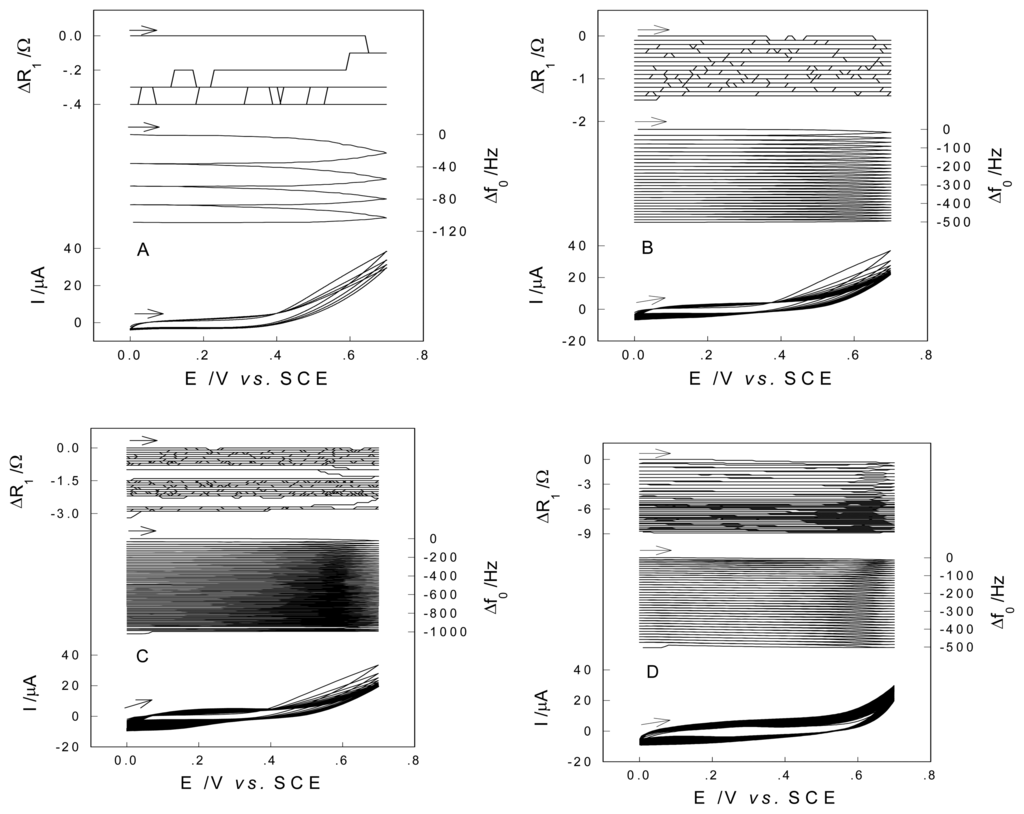
Figure 1.
Simultaneous records of current (I), Δf0 and ΔR1 during the cyclic voltammetric polymerization in 20 mM pyrrole + 5.0 mM tannic acid aqueous solution (A: Δf0 = -100 Hz; B: Δf0 = -500 Hz; C: Δf0 = -1000 Hz) as well as in 20 mM pyrrole + 5.0 mM NaClO4 aqueous solution at pH 3.7 (D: Δf0 = -500 Hz). dE/dt =50 mV/s.
Soon after the onset of oxidation of pyrrole monomer at potentials positive to ca. 0.4 V in all cases, the EQCM frequency decreased, indicating the polymerization of monomers and simultaneously polymer deposition on the PQC electrode surface. The monomer-oxidation current for PPY/TA was gradually decreasing but that for PPY/ClO4- was increasing cycle by cycle, which may imply that the growth of PPY/ClO4- film here involved a self-catalysis mechanism. The R1 value for PPY/TA or PPY/ClO4- decreased cycle by cycle during polymerization, suggesting that both films were rigid and the PPY/ClO4- film was more rigid than the PPY/TA film. It took ca. 13 min when the PPY/TA film growth caused a frequency decrease of 500 Hz, while ca. 17 min for a 500 Hz PPY/ClO4- film. The tannin acid molecules are of large molecular size and molecular weight, and they should be deeply entrapped in the polypyrrole backbone during polymerization, thus it took less time to form a 500 Hz PPY/TA film.
3.2. Electrochemical behavior of polymers
Figures 2 and 3 show the cyclic voltammetric responses, Δf0 and ΔR1 of a 500 Hz PPY/ClO4- and a 500 Hz PPY/TA film-coated quartz crystal electrode, respectively. The primary solution was 0.1 M HClO4 aqueous solution, and then the solution pH was adjusted to pH 2.8, 3.7, 7.4 or 11.3 by adding 2.0 M NaOH.
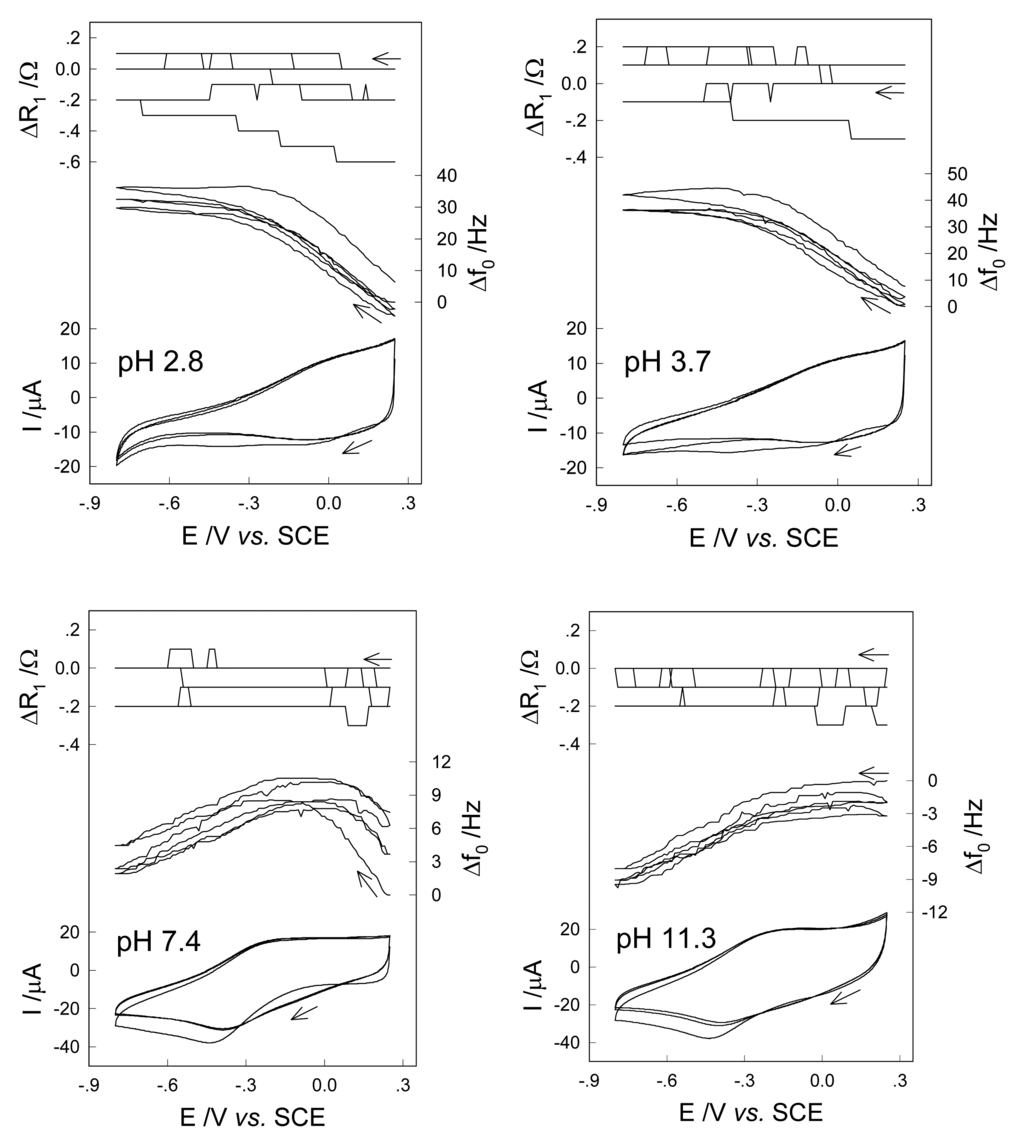
Figure 2.
Simultaneous records of current (I), Δf0, and ΔR1 during cyclic potential switching of a 500 Hz PPY/ClO4- film in 0.1 M HClO4 aqueous solution whose pH values were adjusted by adding 2.0 M NaOH; dE/dt =50 mV/s.
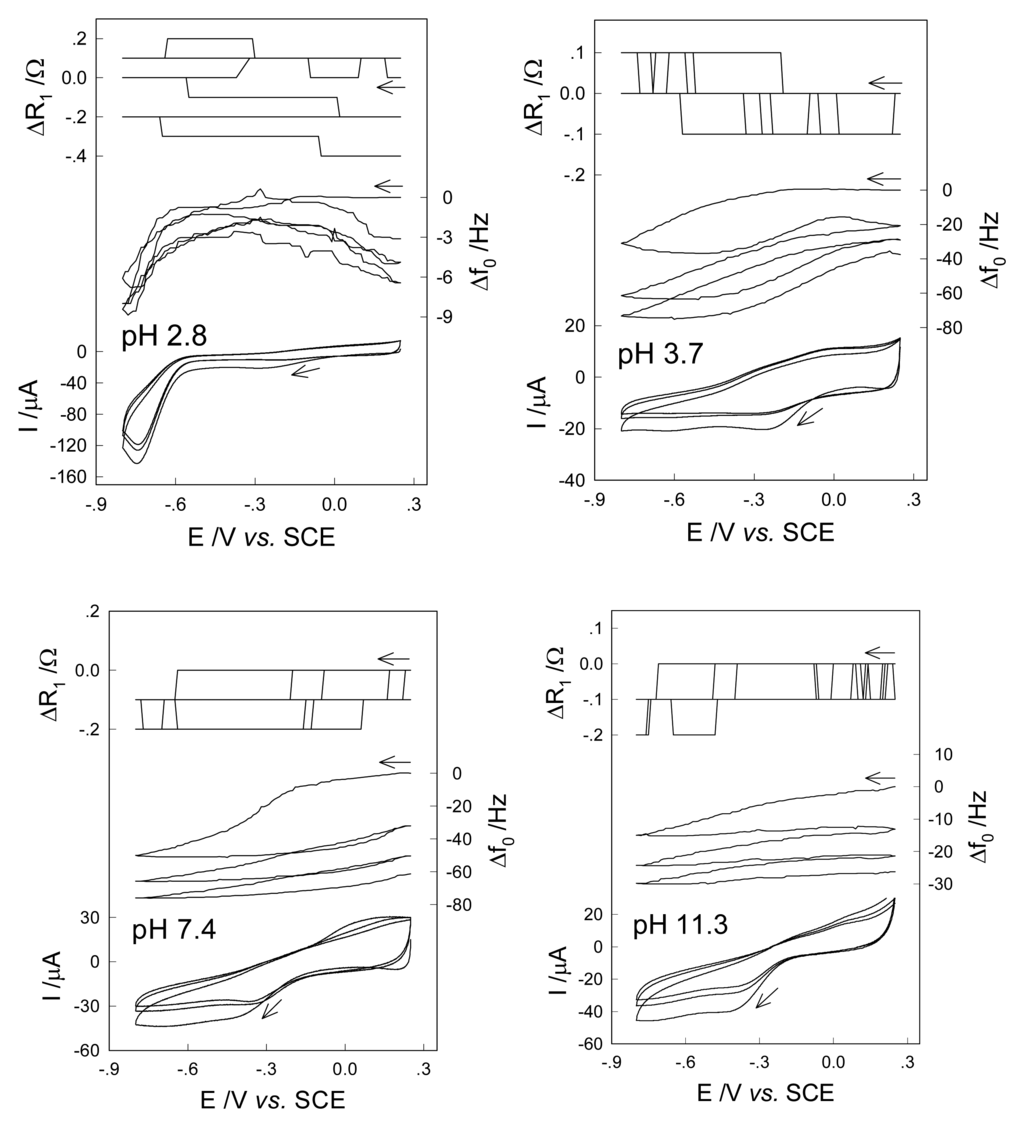
Figure 3.
Simultaneous records of current (I), Δf0, and ΔR1 during cyclic potential switching of a 500 Hz PPY/TA film in 0.1 M HClO4 aqueous solution whose pH values were adjusted by adding 2.0 M NaOH; dE/dt =50 mV/s.
It is seen from Figure 2 for the PPY/ClO4- film that, at pH 2.8 and 3.7, the frequency decreased or increased monotonically with potential scans toward the positive or negative direction, respectively. These findings suggest that the anions were inserted into the film on its electrochemical oxidation and expulsed on its electrochemical reduction (anion doping/elimination behavior) [22]. For various solution pH values, the R1 responses were very small, demonstrating the mass effect dominated the frequency responses. When the solution pH was changed to pH 7.4, the potential for the reduction current peak changed from ca. -0.05 V to ca. -0.4 V. Simultaneously, the peak-type frequency response was observed, namely, an obvious frequency increase followed by its decrease with a vertex at ca. -0.1 V was found during the anodic switching. At pH 11.3, the frequency almost increased monotonically when the potential was shifted positively. These facts suggest that the PPY/ClO4- film exhibited apparent anion doping/elimination in relatively strong acidic aqueous solution, then the cation doping/elimination behavior became more and more obvious when the solution pH was changed toward the neutral and alkaline direction, in accordance with our previous report [22].
The electrochemical behavior of the PPY/TA films found, as shown in Figure 3, is different from the PPY/ClO4- films. First, the PPY/TA films may be more porous than the PPY/ClO4- films, since, at pH 2.8, a large current peak for proton reduction was found at –0.8 V. Second, the frequency responses showed almost complete cation doping/elimination behavior during potential switching at pH 3.7 and above, even at pH 2.8 the cation doping/elimination behavior was also found, and the anion doping/elimination effect was much smaller than in the PPY/ClO4- case. Therefore, the doped tannic acid molecules exist dominantly as anions if the solution pH is above pH 3.7, and at pH 2.8, part of doped tannic acid has been deprotonated, implying that the pKa value of the doped tannic acid is smaller than 3.7. Third, the Δf0, ΔR1 and current responses for a freshly grown 500 Hz PPY/TA film were experimentally found not to be so reproducible to the 15-cycle potential switching at pH 3.8. The findings may be understood as follows. The tannin acid molecules are of large molecular size and the resultant steric hindrance may affect the compact growth of PPY chains during pyrrole polymerization, the PPY/TA films were thus more porous than the PPY/ClO4- films. The tannin acid molecules of large size should be deeply entrapped in the polypyrrole backbone as doping anions during polymerization; they can hardly be removed from the PPY backbone like small-size anions such as ClO4-. At pH 3.7 and above, the tannic acid molecule should be negatively charged via phenol hydroxyl ionization. Therefore, when the PPY backbone was reduced to its uncharged state, the negatively charged tannin acid molecules deeply entrapped in the PPY backbone should take solution cations into the film; and the negatively charged tannic acid molecules could compensate the positive charges in the PPY backbone when oxidized (self-doping), with which the elimination of the freely movable cations of small size was accompanied, resulting in a cation doping/elimination behavior during PPY reduction/oxidation. The PPY/TA film here behaved similarly to the polypyrrole films doped with other anions having large molecular size [1, 22].
3.2. Cation permselectivity of modified electrodes
The electrochemical oxidation of the DA and AA corresponds to a two-electron deprotonation process [13, 14], and the almost same oxidation potential of AA as DA at a bare electrode resulted in poor selectivity for detection of DA at a bare electrode [13]. Here, in order to better characterize the permselectivity of the PPY/TA film-modified electrodes, a couple of inorganic ions were chosen, i.e. Fe(CN)63- and Ru(NH3)63+. The cyclic voltammograms for 5.0 mM ascorbic acid (A), 0.1 mM dopamine (B), 5.0 mM Fe(CN)63- (C), and 5.0 mM Ru(NH3)63+ (D) in a PBS buffer (pH 7.4) at a bare and a 300 Hz PPY/TA film-modified electrodes are shown in Figure 4. As it is seen, the negatively charged film effectively excluded anionic species (Fe(CN)63- and AA) from the surface while the oxidation peak current of cationic species (Ru(NH3)63+ and DA) decreased only slightly. Here we found that the 300 Hz PPY/TA film modification completely blocked the redox reaction of Fe(CN)63-/Fe(CN)64-, but AA oxidation currents were still visible. Then, we examined the film-thickness effect on the film repellent ability for Fe(CN)63- and AA for selecting optimal film thickness. We found that the 500 Hz PPY/TA film could effectively block the redox current of AA while the oxidation of DA still occurred. In this work, the 500 Hz PPY/TA film is thus chosen for detecting DA to exclude the redox activity of AA.
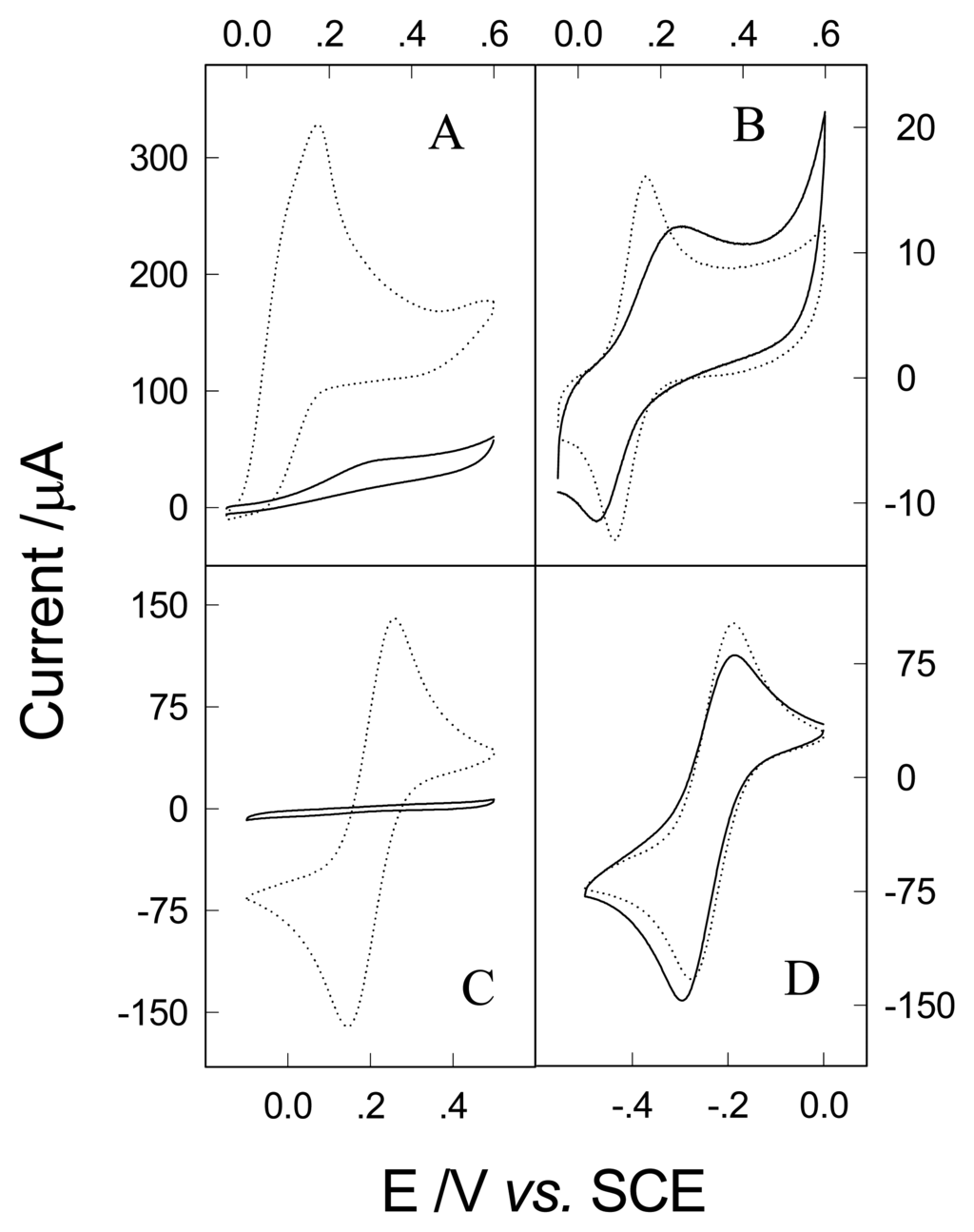
Figure 4.
Cyclic voltammograms of 5.0 mM ascorbic acid (A), 0.1 mM dopamine (B), 5.0 mM Fe(CN)63- (C) and 5.0 mM Ru(NH3)63+ (D) in PBS buffer (pH 7.4) at bare (dashed lines) and 300 Hz PPY/TA film-modified Au electrodes (solid lines).
It should be noted that the blocking effect of PPY/ClO4- film on AA oxidation is very poor, as shown in Figure 5. Despite the PPY/TA films being more porous than the PPY/ClO4- films, the oxidation of AA can be totally suppressed at the 500 Hz PPY/TA film, which is attributed to higher density of phenyl, carbonyl and hydroxyl groups of tannic acid molecules which were entrapped in PPY/TA films during electropolymerization, thus the PPY/TA films has higher electron density which can repel anions.
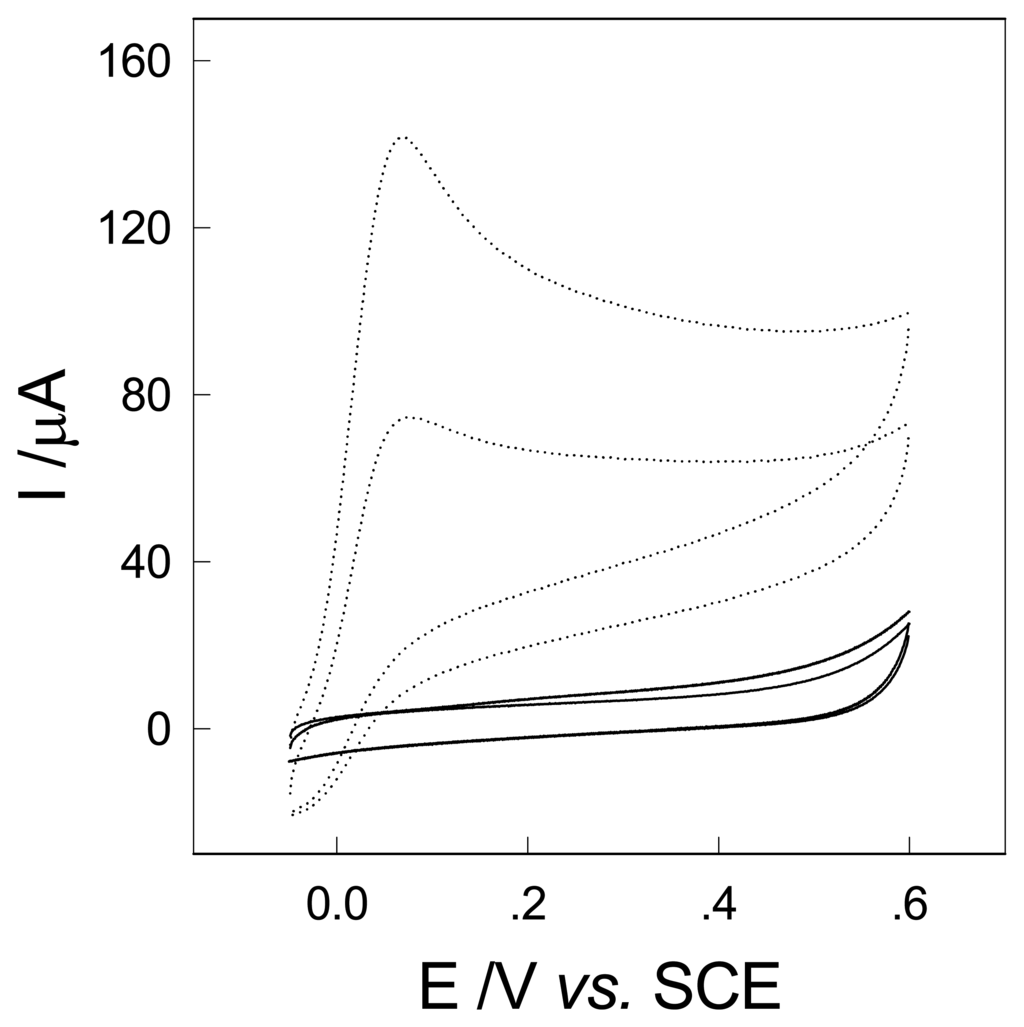
Figure 5.
Cyclic voltammograms of 5.0 mM ascorbic acid in PBS buffer (pH 7.4) at Au electrode modified with a 500 Hz PPY/TA film (solid line) and a 500 Hz PPY/ClO4- film (dashed line). dE/dt=100 mV/s.
3.3. Detection of DA in the presence of AA
Differential pulse voltammetry has been widely used for the sensitive detection of dopamine [4]. To acquire a more distinguished voltammogram, differential pulse voltammetry (DPV) was employed in the following experiments.
The conditions of DPV were: scan rate 4 mV/s; pulse amplitude 50 mV; pulse width 50 ms and pulse time 200 ms. Figure 6 shows the DPV peak current of ascorbic acid at an Au electrode modified with a 500 Hz PPY/TA film, whose concentrations were varied from 0.2 to 100 mM in a PBS buffer (pH 7.4). When the AA concentration was 5.0 mM or below, the oxidation of AA was repelled. However, the AA-oxidation currents were still obvious when the AA concentration was at 10 mM or above, because the hydrophobic interaction between AA and the polymer might become more obvious when the AA concentration was high. Compared with the AA concentration in many biological samples, e.g., ca. 200 μM in rat brain tissue, the ability for excluding AA is favorably sufficient.
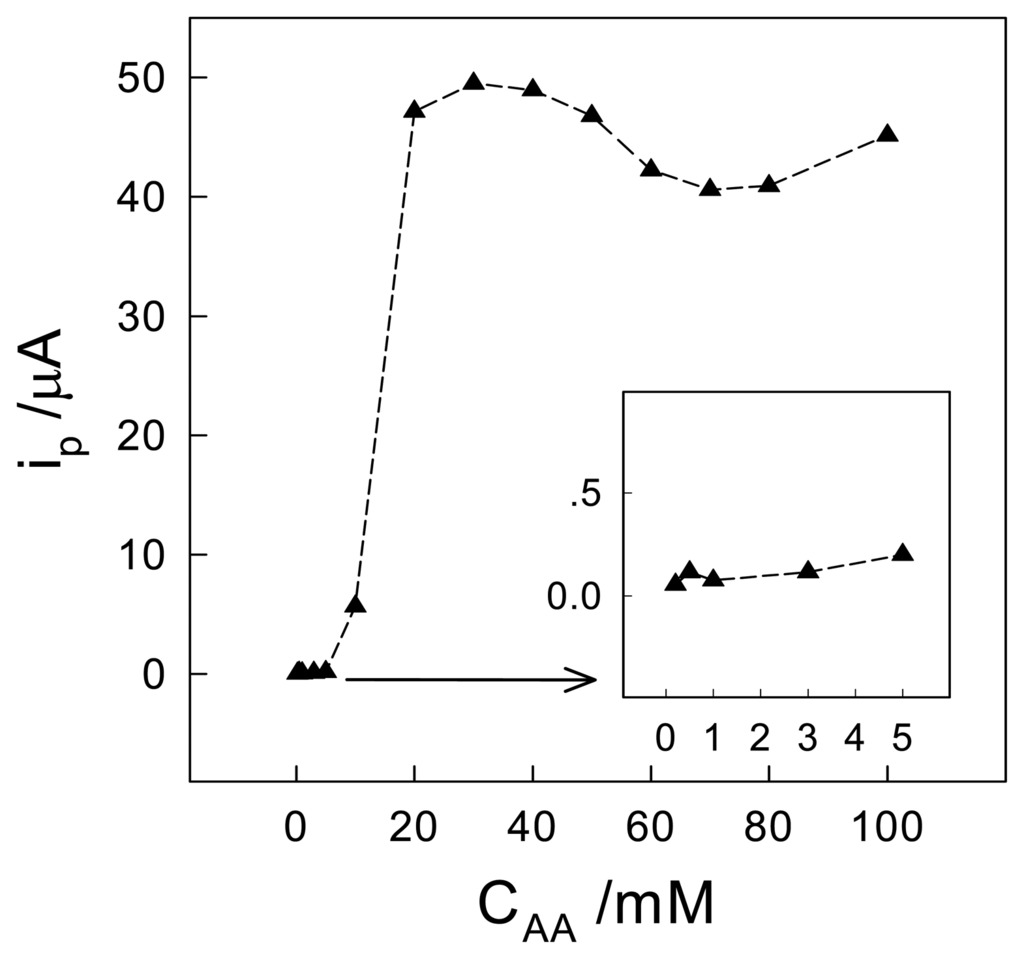
Figure 6.
DPV peak current for ascorbic acid oxidation in PBS buffer (pH 7.4) at an Au electrode modified with a 500 Hz PPY/TA film.
Figure 7(A) shows the DPV peak current of dopamine in an ascorbic acid-containing PBS buffer (pH 7.4) at an Au electrode modified with a 500 Hz PPY/TA film. The peak current curved toward the DA concentration axis when the DA concentration was high, and the highest sensitivity was found in the presence of 1.0 mM AA. Below 10 μM DA, the peak current was proportional to the DA concentration in all cases, as shown in Figure 7(B), suggesting that saturation of negative site occurred above the DA concentration of 10 μM [3, 4, 25]. The presence of AA increased the DA-assay sensitivity [13, 18], e.g., 0.125 μA/μM without AA and 0.268 μA/μM with 1.0 mM AA in this work, as shown in Figure 7(B). The detection limit for DA (S/N=3) was 2.0 μM without AA, and 0.3 μM with 1.0 mM AA coexisting in the measuring solution, respectively. The fact that the coexistence of ascorbic acid in the measurement solution notably enhanced the current signal for dopamine oxidation is probably due to the chemical regeneration of dopamine through an ascorbic acid-catalyzed reduction of the electro-oxidation product of dopamine (EC’ mechanism). However, the current decrease in DA-oxidation at ascorbic acid concentrations above 1.0 mM can not be explained by the EC’ mechanism alone, namely, other factors whose mechanism is unknown at present took effect. A similar tendency can also be identified for DA oxidation at glassy carbon electrodes modified with a melanin-type polymer [18]. Malem et al. showed that this catalytic effect was absent at a 10-μm-diameter micro-electrode modified with a self-assembled monolayer of carboxylic end groups [14], because the oxidized dopamine diffuses away from the micro-electrode before it has a chance to react with AA and contribute to the catalytic enhancement.
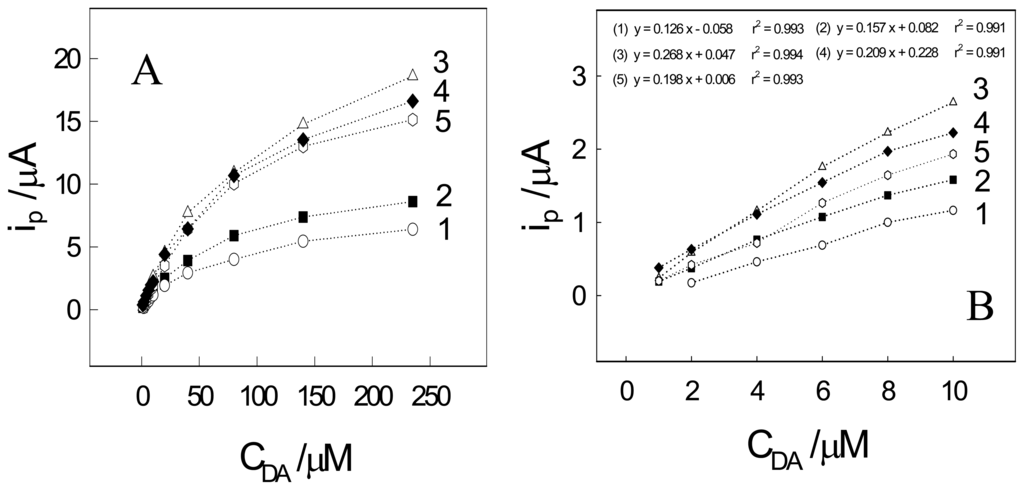
Figure 7.
DPV peak current of dopamine oxidation at 500 Hz PPY/TA film-modified electrodes versus DA concentration in PBS buffer (pH 7.4) containing different amount of ascorbic acid. AA concentrations for curves 1-5 are 0, 0.2, 1.0, 3.0 and 5.0 mM, respectively. (A) whole DA concentrations, (B) low DA concentrations.
4. Conclusions
Electrochemical quartz crystal microbalance (EQCM) studies have indicated that the PPY/TA film shows redox processes that involve only cation transport when the solution pH is greater than 3-4. The PPY/TA films grown showed good cation permselective behavior, and a 500 Hz PPY/TA film completely suppressed the redox oxidation of 5 mM AA while well retaining the DA-oxidation activity. The coexistence of ascorbic acid in the measurement solution allows the amplification of the dopamine oxidation signal, and 1.0 mM AA is the optimal concentration for this purpose.
The strong discrimination of PPY/TA between cationic and anionic species makes this new polymer potentially useful probably for the effective and highly selective quantification of neurotransmitters and as a permselective barrier and matrix for immobilizing enzymes in biosensor developments. Current work in our laboratory is being performed in this direction.
Acknowledgments
This work was supported by the National Science Foundation of China (20275010, 20335020), the Basic Research Special Program of the Ministry of Science and Technology of China (2003CCC00700), and the Foundation of the Ministry of Education (MOE) of China (jiaorensi [2000] 26, jiaojisi [2000] 65).
References and Notes
- Basak, S.; Bose, C. S. C.; Rajeshwar, K. Anal. Chem. 1992, 64, 1813.
- Tüdὅs, A. J.; Ozinga, W. J.; Poppe, H.; Kok, W. T. Anal. Chem. 1990, 62, 367.
- Hsueh, C.; Brajter-Tpth, A. Anal. Chem. 1994, 66, 2458.
- Zhao, H.; Zhang, Y.; Yuan, Z. Anal. Chim. Acta 2001, 441, 117.
- Ciszewski, A.; Milczarek, G. Anal. Chem. 1999, 71, 1055.
- Roy, P.; Okajima, T.; Ohsaka, T. Bioelectrochem 2003, 59, 11.
- Sun, Y.; Ye, B.; Zhang, W.; Zhou, X. Anal. Chim. Acta 1998, 363, 75.
- Cheng, Q.; Braiter-Toth, A. Anal. Chem. 1992, 64, 1998.
- Mousty, C.; Bergamasco, J.; Wessel, R.; Perrot, H.; Cosnier, S. Anal. Chem. 2001, 73, 2890.
- Garnier, F.; Korri-youssonfi, H.; Srivastava, P.; Mandrand, B.; Delair, T. Synth. Met. 1999, 100, 89.
- Raj, R.; Tokuda, K.; Ohsaka, T. Bioelectrochem 2001, 53, 183.
- Hulthe, P.; Hulthe, B.; Johannessen, K.; Engel, J. Anal. Chim. Acta 1987, 198, 197.
- Dalmia, A.; Liu, C. C.; Savinell, R.F. J. Electroanal. Chem. 1997, 430, 205.
- Malem, F.; Mandler, D. Anal. Chem. 1993, 65, 37.
- Dayton, M. A.; Ewing, A. G.; Wrightman, R. M. Anal. Chem. 1980, 52, 2392.
- Selvarajn, T.; Ramaraj, R. Electrochem. Commun. 2003, 5, 667.
- Miyazaki, K.; Matsumoto, G.; Yamada, M.; Yasui, S.; Kaneko, H. Electrochim. Atca 1999, 44, 3809.
- Rubianes, M. D.; Rivas, G. A. Anal. Chim. Acta 2001, 440, 99.
- Nagy, G.; Gerhardt, G. A.; Oke, A. F.; Rice, M. E.; Adams, R. N. J. Electroanal. Chem. 1985, 188, 85.
- Kristensen, E. W.; Kuhr, W. G.; Wightman, R. M. Anal. Chem. 1987, 59, 1752.
- Nakamura, Y.; Tsui, S.; Tonogai, Y. J Agric. Food. Chem. 2003, 51, 331.
- Xie, Q.; Kuwabata, S.; Yoneyama, H. J. Electroanal. Chem. 1997, 420, 219.
- Zhou, A.; Xie, Q.; Yuan, Y.; Zhang, Y.; Yao, S. Anal. Chim. Acta 2000, 419, 251.
- Xie, Q.; Xiang, C.; Yuan, Y.; Zhang, Y.; Nie, L.; Yao, S. J. Colloid Interface Sci. 2003, 262, 107.
- Witkowski, A.; Brajter-Toth, A. Anal. Chem. 1992, 64, 635.
© 2005 by MDPI ( http://www.mdpi.org). Reproduction is permitted for noncommercial purposes.